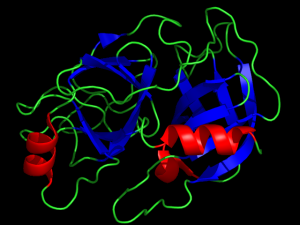
The trypsin protease cleaves proteins on the carboxyterminus of Arginine (Arg) and Lysine (Lys). This cleavage reaction leaves a positive charge on the C-terminus of the resulting peptide, which enhances mass spectrometry analysis (1,2). Because of this advantage, trypsin has become the most commonly used protease for mass spectrometry analysis. Other proteases which cleave differently from trypsin, yielding complementary data are also used in mass spec analysis: these include Asp-N and Glu-C , which cleave acidic residues, and chymotrypsin which cleaves at aromatic residues. The broad spectrum protease, proteinase K is also used for some proteomic analyses. In a recent study, Dau and colleagues investigated whether sequential digestion with trypsin followed by the complementary proteases could improve protein digests for mass spectrometry analysis.
The work by Dau et al. looked at digestion yeast S. pombe lysate with and without sequential digestion with trypsin (3). Briefly, lysate from S. pombe was digested with trypsin, Asp-N, Glu-C, chymotrypsin, elastase or proteinase K as control. Or lysate was digested with a sequential digestion of trypsin followed by one or a combination of other proteases, with trypsin digestion first or second in the sequence.
Dau et al. found that trypsin predigestion improved the number of peptides identified by mass spectrometry analysis. The sequential digest with trypsin and Asp-N yielded even a higher number of protein identifications than digesting with trypsin alone.
References
- Dongré, A. R. et al. (1996). Influence of Peptide Composition, Gas-Phase Basicity, and Chemical Modification on Fragmentation Efficiency: Evidence for the Mobile Proton Model. Am.Chem. Soc. , 118 (35), 8365−8374.
- Huang, V. et al. (2005). Statistical Characterization of the Charge State and Residue Dependence of Low-Energy CID Peptide Dissociation Patterns. Anal. Chem. 2005, 77, 18, 5800–5813
- Dau, T. et al. (2020) Proteomics Using Protease Alternatives to Trypsin Benefits from Sequential Digestion with Trypsin. Anal. Chem. 92, 9523−9527
Try a sample of high-efficiency Trypsin Platinum today!
Visit our website for more on Trypsin Platinum, Mass Spectrometry Grade, with enhanced proteolytic efficiency and superior autoproteolytic resistance.
Are you looking for proteases to use in your research?
Explore our portfolio of proteases today.
Don’t go anywhere, you can learn more about protein digestion and mass spec analysis right here on the Promega Connections blog.
